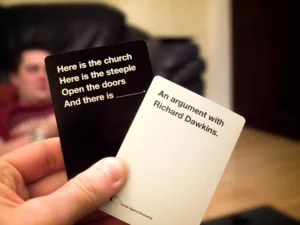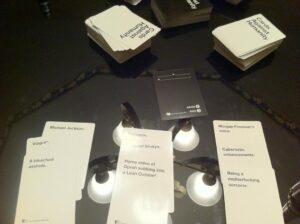Critical Play: Cards Against Humanity

Cards Against Humanity is a party game that has become increasingly popular over the years. This game is designed for young adults who enjoy a saucy and humorous game to play with their friends or with people they want to get to know better. I played the game with 7 players in 14 rounds, with each player submitting an answer to a prompt card in each round. The game usually takes 25 minutes to play, but can be adjusted as per the players’ preference. In this essay, we will explore the different formal elements of Cards Against Humanity and how it excels as a game of discovery and expression.
The game’s formal elements consist of a prompt card, which is a black card with a sentence that has a blank space in it. The players submit their answers on a white card to fill in the blank space in the prompt. The judge or moderator, who is usually the player who submitted the prompt card, reads out the filled-in prompts to the group, and there is an art to narrating these prompts to achieve utmost levity and merriment from the group. The game is designed to be a party game or drinking game, and the prompts are often NSFW or humorous in nature.
Cards are judged anonymously, and there is subjectivity to the best card. Sometimes, one point is awarded to the best card, and sometimes all the cards are ranked, and a total tally of points is done. The highest scorer wins in either case. Judgement can happen in a number of ways, such as designated judge per round, one judge in the whole game, consensus or vote-based judging. There can be discussions on what was the funniest, and players often lead by saying which card generated most laughter.

The discovery element of Cards Against Humanity is what makes the game truly exciting. The game is similar to charades, and the strict set of rules that come with the game allows groups to adjust the game to suit their preferences. For instance, groups can add time limits, guess which card belongs to which player, veto cards for prompts that are too NSFW, and so on. The game is often fun to cycle through new cards and learn new and crazy responses to classic prompt cards. Through the game, a player discovers new and eccentric ways to build a prompt, but often the room follows up on responses to old prompts. Many groups create somewhat of an emergent narrative by linking old prompts (filled in) to filling in of new prompts.
Expression is another key element of Cards Against Humanity. One iteration of the game is to only use the prompt cards and generate your answers to the prompt cards. This lets the players engage their humor writing and go wild with creative ideas. In other instances, players try to be as wild and creative as possible with their limited resources. The game encourages players to express themselves in a humorous and creative way, which is why it is so appealing to young adults.

In conclusion, Cards Against Humanity is a game that excels in providing levity and merriment to players. This is an ideal game to discover a quirky side of a friend, even if they are shy, because they are able to submit their answers anonymously at the start of the game. Unlike other games that are NSFW, like Draw Without Dignity, a player does not have to reveal themselves at the point of drawing, which is harder for introverts in a group of acquaintances. However, Draw Without Dignity is more collaborative but Cards Against Humanities is more competitive as the players are trying to outwit each other. In finality, CAH is a game that is perfect for young adults who enjoy a saucy and humorous game to play with their friends or with people they want to get to know better.



